Analysis of Winslow Homer's 'Breezing Up' Painting: A Fair Wind
VerifiedAdded on 2022/09/14
|6
|1590
|14
Report
AI Summary
This report provides a detailed analysis of Winslow Homer's painting, 'Breezing Up: A Fair Wind,' examining its historical context, artistic techniques, and cultural significance. The paper begins with an introduction to Winslow Homer, an influential American artist, and the background of the artwork. It then explores the painting's creation, including the influences of French marine paintings and Japanese art. The analysis delves into the painting's elements and principles, such as composition, color, and the depiction of movement. The report discusses how the artwork reflects the era in which it was created, including the post-Civil War period and the rise of American identity. Furthermore, the report argues for the preservation of the artwork, highlighting its importance as an iconic representation of American life and art history. The analysis includes references to the painting's exhibition history and critical reception, along with a discussion of the painting's lasting impact and its place within the broader context of American art. The report concludes by emphasizing the painting's enduring value and its significance as a cultural artifact.
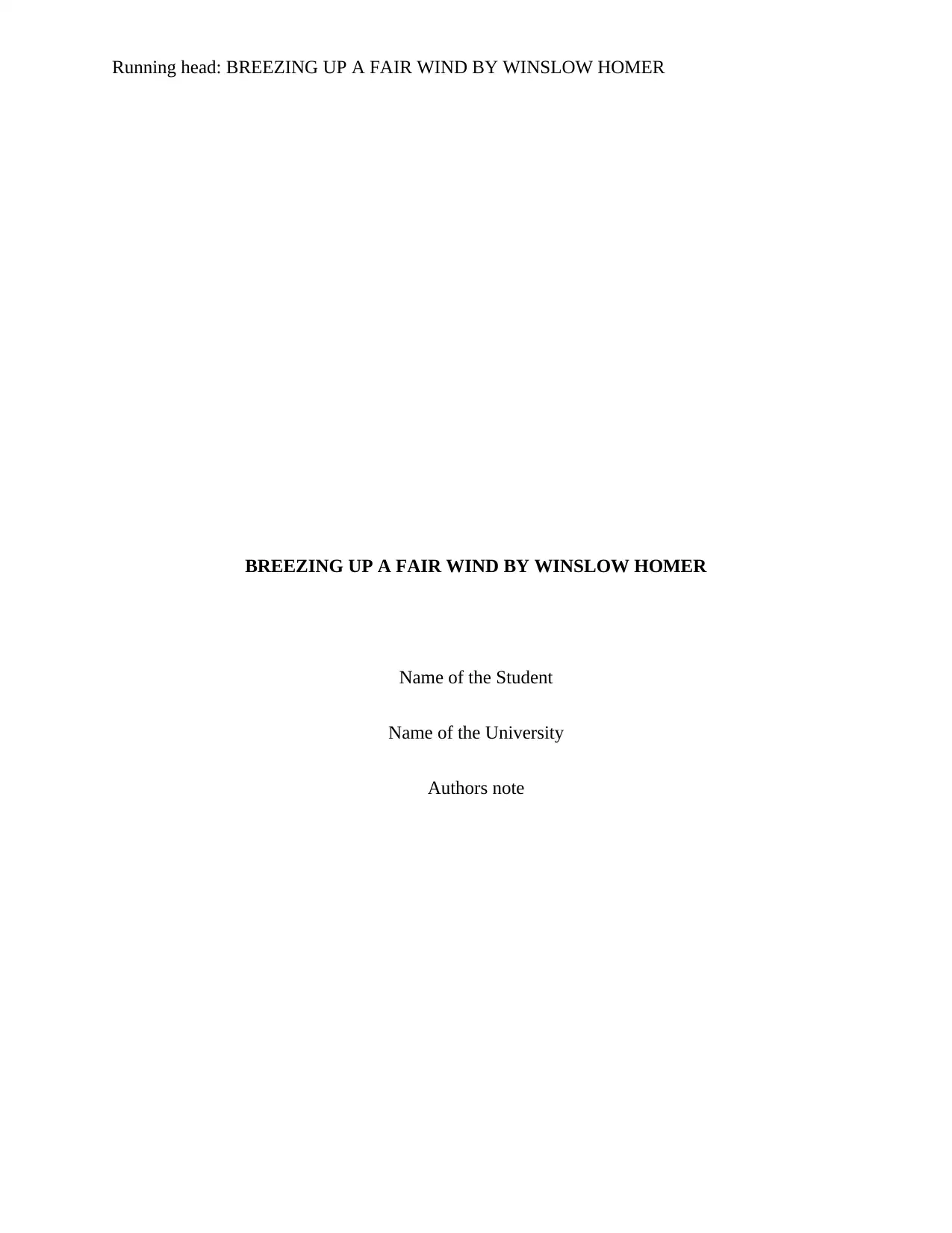
Running head: BREEZING UP A FAIR WIND BY WINSLOW HOMER
BREEZING UP A FAIR WIND BY WINSLOW HOMER
Name of the Student
Name of the University
Authors note
BREEZING UP A FAIR WIND BY WINSLOW HOMER
Name of the Student
Name of the University
Authors note
Paraphrase This Document
Need a fresh take? Get an instant paraphrase of this document with our AI Paraphraser
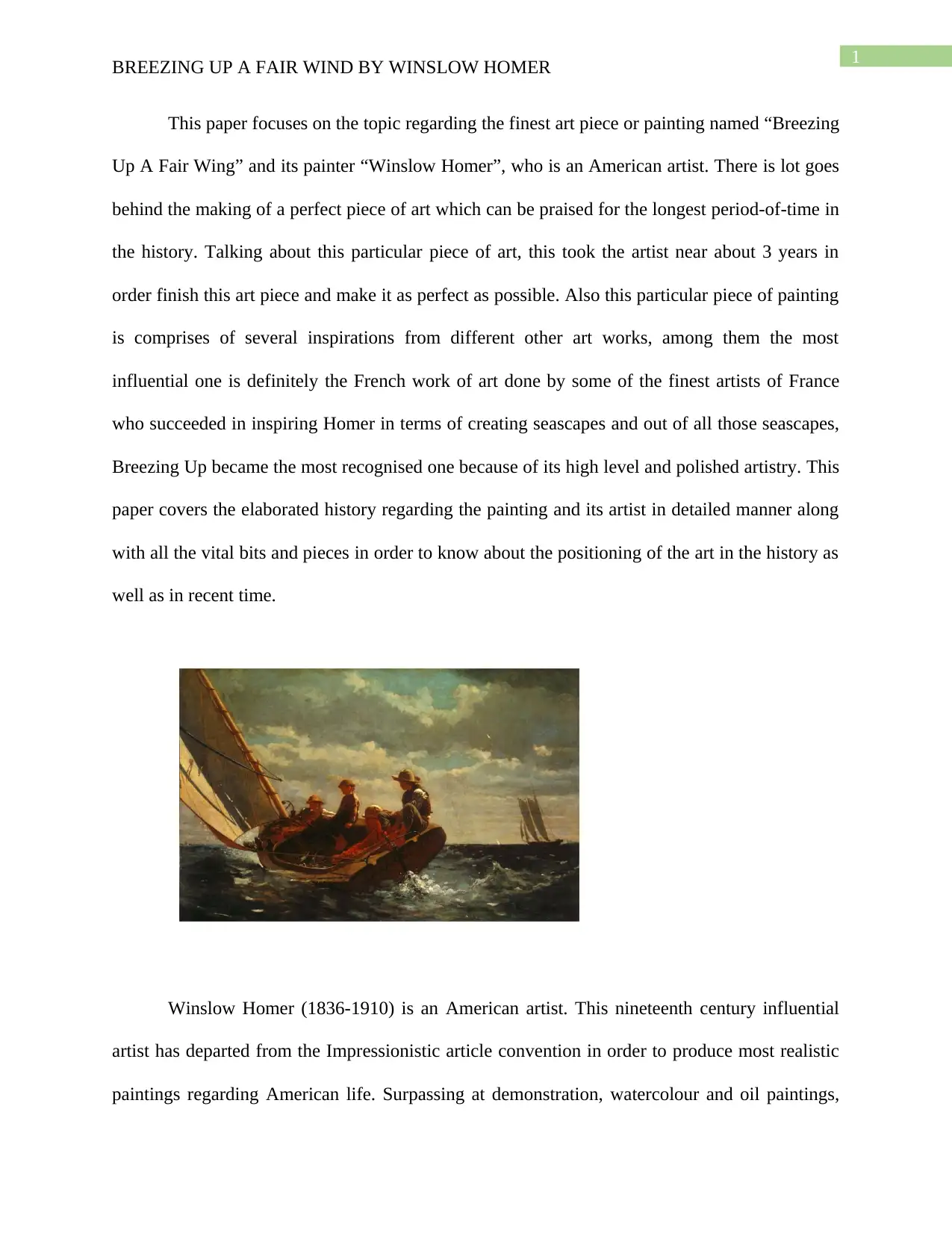
1
BREEZING UP A FAIR WIND BY WINSLOW HOMER
This paper focuses on the topic regarding the finest art piece or painting named “Breezing
Up A Fair Wing” and its painter “Winslow Homer”, who is an American artist. There is lot goes
behind the making of a perfect piece of art which can be praised for the longest period-of-time in
the history. Talking about this particular piece of art, this took the artist near about 3 years in
order finish this art piece and make it as perfect as possible. Also this particular piece of painting
is comprises of several inspirations from different other art works, among them the most
influential one is definitely the French work of art done by some of the finest artists of France
who succeeded in inspiring Homer in terms of creating seascapes and out of all those seascapes,
Breezing Up became the most recognised one because of its high level and polished artistry. This
paper covers the elaborated history regarding the painting and its artist in detailed manner along
with all the vital bits and pieces in order to know about the positioning of the art in the history as
well as in recent time.
Winslow Homer (1836-1910) is an American artist. This nineteenth century influential
artist has departed from the Impressionistic article convention in order to produce most realistic
paintings regarding American life. Surpassing at demonstration, watercolour and oil paintings,
BREEZING UP A FAIR WIND BY WINSLOW HOMER
This paper focuses on the topic regarding the finest art piece or painting named “Breezing
Up A Fair Wing” and its painter “Winslow Homer”, who is an American artist. There is lot goes
behind the making of a perfect piece of art which can be praised for the longest period-of-time in
the history. Talking about this particular piece of art, this took the artist near about 3 years in
order finish this art piece and make it as perfect as possible. Also this particular piece of painting
is comprises of several inspirations from different other art works, among them the most
influential one is definitely the French work of art done by some of the finest artists of France
who succeeded in inspiring Homer in terms of creating seascapes and out of all those seascapes,
Breezing Up became the most recognised one because of its high level and polished artistry. This
paper covers the elaborated history regarding the painting and its artist in detailed manner along
with all the vital bits and pieces in order to know about the positioning of the art in the history as
well as in recent time.
Winslow Homer (1836-1910) is an American artist. This nineteenth century influential
artist has departed from the Impressionistic article convention in order to produce most realistic
paintings regarding American life. Surpassing at demonstration, watercolour and oil paintings,
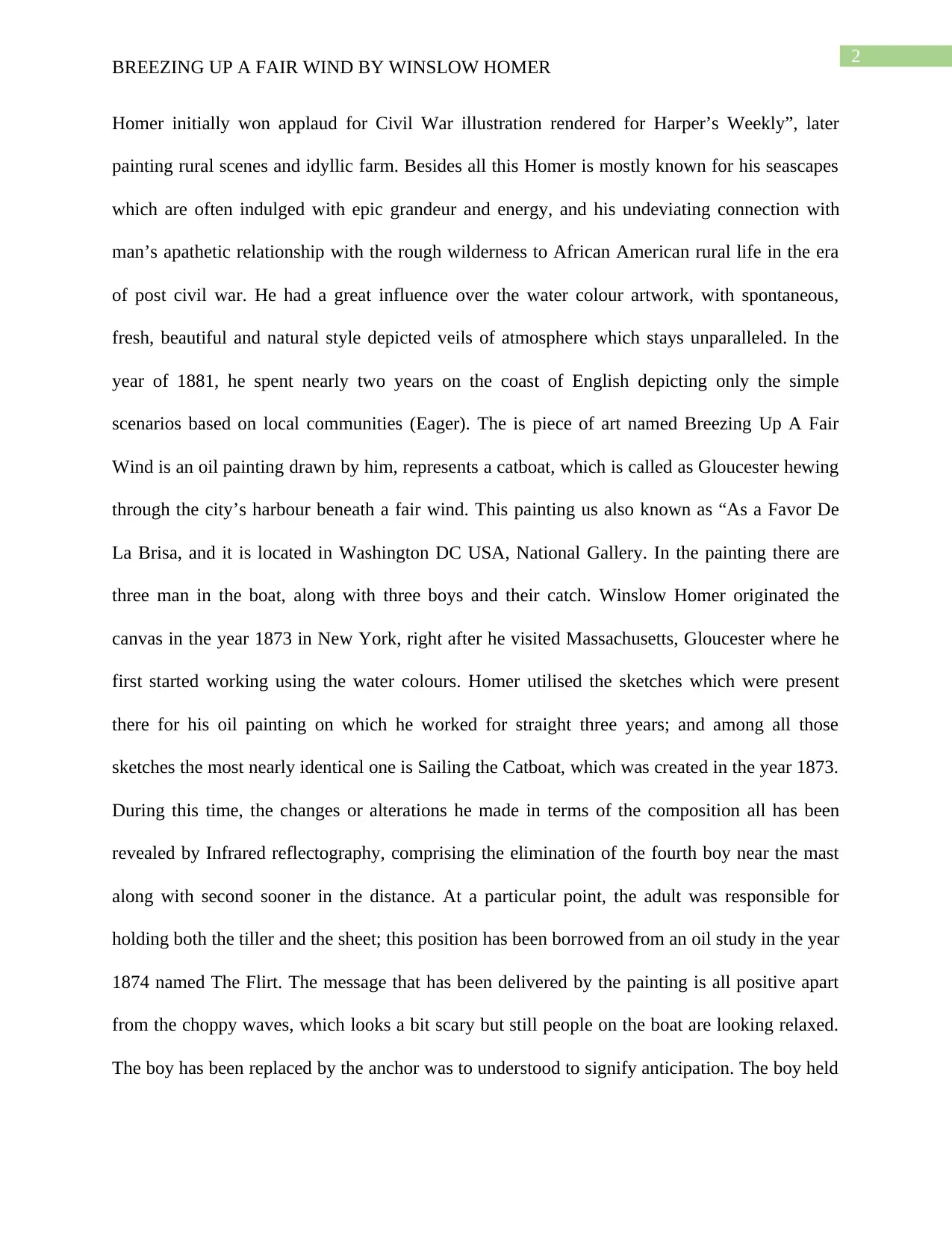
2
BREEZING UP A FAIR WIND BY WINSLOW HOMER
Homer initially won applaud for Civil War illustration rendered for Harper’s Weekly”, later
painting rural scenes and idyllic farm. Besides all this Homer is mostly known for his seascapes
which are often indulged with epic grandeur and energy, and his undeviating connection with
man’s apathetic relationship with the rough wilderness to African American rural life in the era
of post civil war. He had a great influence over the water colour artwork, with spontaneous,
fresh, beautiful and natural style depicted veils of atmosphere which stays unparalleled. In the
year of 1881, he spent nearly two years on the coast of English depicting only the simple
scenarios based on local communities (Eager). The is piece of art named Breezing Up A Fair
Wind is an oil painting drawn by him, represents a catboat, which is called as Gloucester hewing
through the city’s harbour beneath a fair wind. This painting us also known as “As a Favor De
La Brisa, and it is located in Washington DC USA, National Gallery. In the painting there are
three man in the boat, along with three boys and their catch. Winslow Homer originated the
canvas in the year 1873 in New York, right after he visited Massachusetts, Gloucester where he
first started working using the water colours. Homer utilised the sketches which were present
there for his oil painting on which he worked for straight three years; and among all those
sketches the most nearly identical one is Sailing the Catboat, which was created in the year 1873.
During this time, the changes or alterations he made in terms of the composition all has been
revealed by Infrared reflectography, comprising the elimination of the fourth boy near the mast
along with second sooner in the distance. At a particular point, the adult was responsible for
holding both the tiller and the sheet; this position has been borrowed from an oil study in the year
1874 named The Flirt. The message that has been delivered by the painting is all positive apart
from the choppy waves, which looks a bit scary but still people on the boat are looking relaxed.
The boy has been replaced by the anchor was to understood to signify anticipation. The boy held
BREEZING UP A FAIR WIND BY WINSLOW HOMER
Homer initially won applaud for Civil War illustration rendered for Harper’s Weekly”, later
painting rural scenes and idyllic farm. Besides all this Homer is mostly known for his seascapes
which are often indulged with epic grandeur and energy, and his undeviating connection with
man’s apathetic relationship with the rough wilderness to African American rural life in the era
of post civil war. He had a great influence over the water colour artwork, with spontaneous,
fresh, beautiful and natural style depicted veils of atmosphere which stays unparalleled. In the
year of 1881, he spent nearly two years on the coast of English depicting only the simple
scenarios based on local communities (Eager). The is piece of art named Breezing Up A Fair
Wind is an oil painting drawn by him, represents a catboat, which is called as Gloucester hewing
through the city’s harbour beneath a fair wind. This painting us also known as “As a Favor De
La Brisa, and it is located in Washington DC USA, National Gallery. In the painting there are
three man in the boat, along with three boys and their catch. Winslow Homer originated the
canvas in the year 1873 in New York, right after he visited Massachusetts, Gloucester where he
first started working using the water colours. Homer utilised the sketches which were present
there for his oil painting on which he worked for straight three years; and among all those
sketches the most nearly identical one is Sailing the Catboat, which was created in the year 1873.
During this time, the changes or alterations he made in terms of the composition all has been
revealed by Infrared reflectography, comprising the elimination of the fourth boy near the mast
along with second sooner in the distance. At a particular point, the adult was responsible for
holding both the tiller and the sheet; this position has been borrowed from an oil study in the year
1874 named The Flirt. The message that has been delivered by the painting is all positive apart
from the choppy waves, which looks a bit scary but still people on the boat are looking relaxed.
The boy has been replaced by the anchor was to understood to signify anticipation. The boy held
⊘ This is a preview!⊘
Do you want full access?
Subscribe today to unlock all pages.

Trusted by 1+ million students worldwide
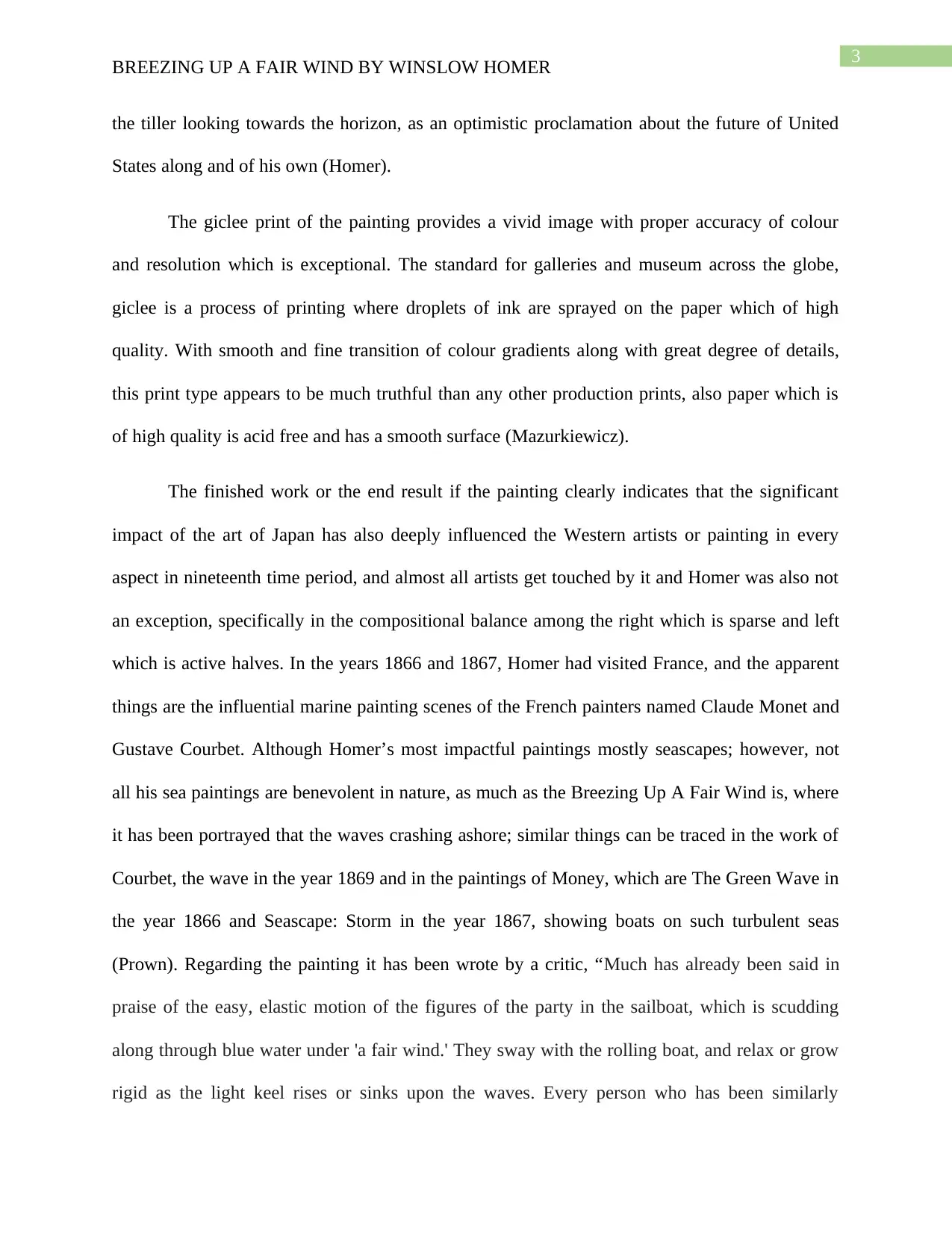
3
BREEZING UP A FAIR WIND BY WINSLOW HOMER
the tiller looking towards the horizon, as an optimistic proclamation about the future of United
States along and of his own (Homer).
The giclee print of the painting provides a vivid image with proper accuracy of colour
and resolution which is exceptional. The standard for galleries and museum across the globe,
giclee is a process of printing where droplets of ink are sprayed on the paper which of high
quality. With smooth and fine transition of colour gradients along with great degree of details,
this print type appears to be much truthful than any other production prints, also paper which is
of high quality is acid free and has a smooth surface (Mazurkiewicz).
The finished work or the end result if the painting clearly indicates that the significant
impact of the art of Japan has also deeply influenced the Western artists or painting in every
aspect in nineteenth time period, and almost all artists get touched by it and Homer was also not
an exception, specifically in the compositional balance among the right which is sparse and left
which is active halves. In the years 1866 and 1867, Homer had visited France, and the apparent
things are the influential marine painting scenes of the French painters named Claude Monet and
Gustave Courbet. Although Homer’s most impactful paintings mostly seascapes; however, not
all his sea paintings are benevolent in nature, as much as the Breezing Up A Fair Wind is, where
it has been portrayed that the waves crashing ashore; similar things can be traced in the work of
Courbet, the wave in the year 1869 and in the paintings of Money, which are The Green Wave in
the year 1866 and Seascape: Storm in the year 1867, showing boats on such turbulent seas
(Prown). Regarding the painting it has been wrote by a critic, “Much has already been said in
praise of the easy, elastic motion of the figures of the party in the sailboat, which is scudding
along through blue water under 'a fair wind.' They sway with the rolling boat, and relax or grow
rigid as the light keel rises or sinks upon the waves. Every person who has been similarly
BREEZING UP A FAIR WIND BY WINSLOW HOMER
the tiller looking towards the horizon, as an optimistic proclamation about the future of United
States along and of his own (Homer).
The giclee print of the painting provides a vivid image with proper accuracy of colour
and resolution which is exceptional. The standard for galleries and museum across the globe,
giclee is a process of printing where droplets of ink are sprayed on the paper which of high
quality. With smooth and fine transition of colour gradients along with great degree of details,
this print type appears to be much truthful than any other production prints, also paper which is
of high quality is acid free and has a smooth surface (Mazurkiewicz).
The finished work or the end result if the painting clearly indicates that the significant
impact of the art of Japan has also deeply influenced the Western artists or painting in every
aspect in nineteenth time period, and almost all artists get touched by it and Homer was also not
an exception, specifically in the compositional balance among the right which is sparse and left
which is active halves. In the years 1866 and 1867, Homer had visited France, and the apparent
things are the influential marine painting scenes of the French painters named Claude Monet and
Gustave Courbet. Although Homer’s most impactful paintings mostly seascapes; however, not
all his sea paintings are benevolent in nature, as much as the Breezing Up A Fair Wind is, where
it has been portrayed that the waves crashing ashore; similar things can be traced in the work of
Courbet, the wave in the year 1869 and in the paintings of Money, which are The Green Wave in
the year 1866 and Seascape: Storm in the year 1867, showing boats on such turbulent seas
(Prown). Regarding the painting it has been wrote by a critic, “Much has already been said in
praise of the easy, elastic motion of the figures of the party in the sailboat, which is scudding
along through blue water under 'a fair wind.' They sway with the rolling boat, and relax or grow
rigid as the light keel rises or sinks upon the waves. Every person who has been similarly
Paraphrase This Document
Need a fresh take? Get an instant paraphrase of this document with our AI Paraphraser
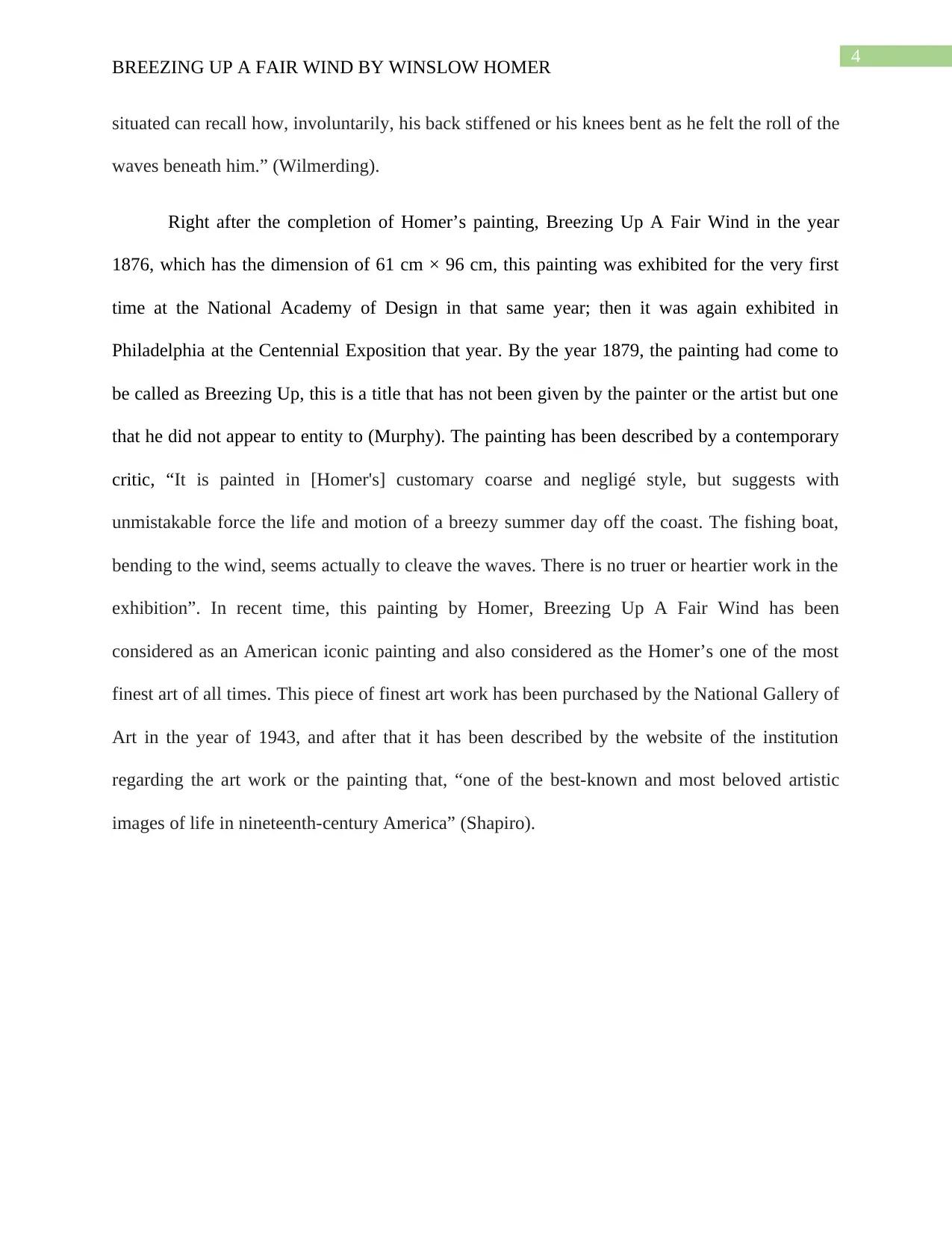
4
BREEZING UP A FAIR WIND BY WINSLOW HOMER
situated can recall how, involuntarily, his back stiffened or his knees bent as he felt the roll of the
waves beneath him.” (Wilmerding).
Right after the completion of Homer’s painting, Breezing Up A Fair Wind in the year
1876, which has the dimension of 61 cm × 96 cm, this painting was exhibited for the very first
time at the National Academy of Design in that same year; then it was again exhibited in
Philadelphia at the Centennial Exposition that year. By the year 1879, the painting had come to
be called as Breezing Up, this is a title that has not been given by the painter or the artist but one
that he did not appear to entity to (Murphy). The painting has been described by a contemporary
critic, “It is painted in [Homer's] customary coarse and negligé style, but suggests with
unmistakable force the life and motion of a breezy summer day off the coast. The fishing boat,
bending to the wind, seems actually to cleave the waves. There is no truer or heartier work in the
exhibition”. In recent time, this painting by Homer, Breezing Up A Fair Wind has been
considered as an American iconic painting and also considered as the Homer’s one of the most
finest art of all times. This piece of finest art work has been purchased by the National Gallery of
Art in the year of 1943, and after that it has been described by the website of the institution
regarding the art work or the painting that, “one of the best-known and most beloved artistic
images of life in nineteenth-century America” (Shapiro).
BREEZING UP A FAIR WIND BY WINSLOW HOMER
situated can recall how, involuntarily, his back stiffened or his knees bent as he felt the roll of the
waves beneath him.” (Wilmerding).
Right after the completion of Homer’s painting, Breezing Up A Fair Wind in the year
1876, which has the dimension of 61 cm × 96 cm, this painting was exhibited for the very first
time at the National Academy of Design in that same year; then it was again exhibited in
Philadelphia at the Centennial Exposition that year. By the year 1879, the painting had come to
be called as Breezing Up, this is a title that has not been given by the painter or the artist but one
that he did not appear to entity to (Murphy). The painting has been described by a contemporary
critic, “It is painted in [Homer's] customary coarse and negligé style, but suggests with
unmistakable force the life and motion of a breezy summer day off the coast. The fishing boat,
bending to the wind, seems actually to cleave the waves. There is no truer or heartier work in the
exhibition”. In recent time, this painting by Homer, Breezing Up A Fair Wind has been
considered as an American iconic painting and also considered as the Homer’s one of the most
finest art of all times. This piece of finest art work has been purchased by the National Gallery of
Art in the year of 1943, and after that it has been described by the website of the institution
regarding the art work or the painting that, “one of the best-known and most beloved artistic
images of life in nineteenth-century America” (Shapiro).
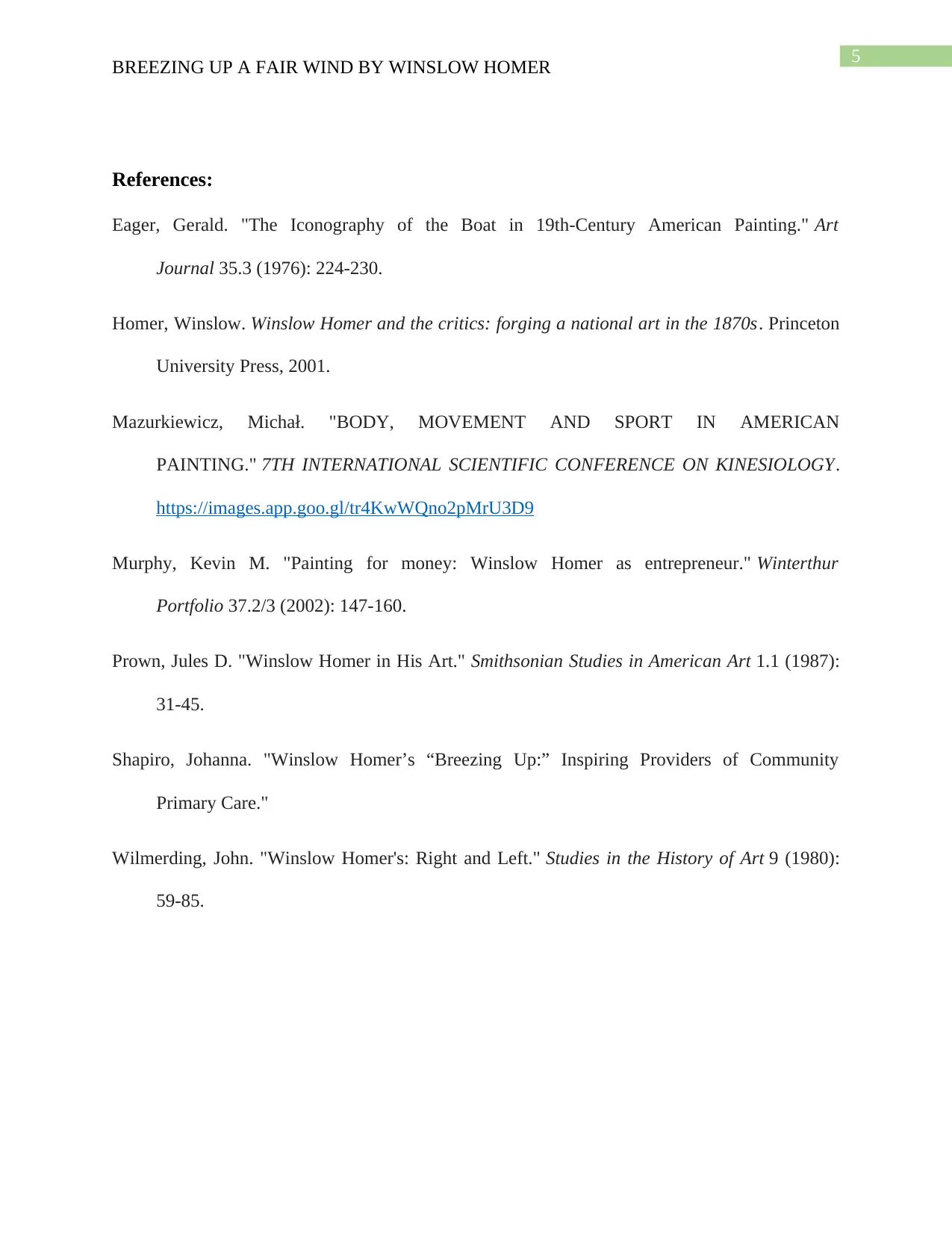
5
BREEZING UP A FAIR WIND BY WINSLOW HOMER
References:
Eager, Gerald. "The Iconography of the Boat in 19th-Century American Painting." Art
Journal 35.3 (1976): 224-230.
Homer, Winslow. Winslow Homer and the critics: forging a national art in the 1870s. Princeton
University Press, 2001.
Mazurkiewicz, Michał. "BODY, MOVEMENT AND SPORT IN AMERICAN
PAINTING." 7TH INTERNATIONAL SCIENTIFIC CONFERENCE ON KINESIOLOGY.
https://images.app.goo.gl/tr4KwWQno2pMrU3D9
Murphy, Kevin M. "Painting for money: Winslow Homer as entrepreneur." Winterthur
Portfolio 37.2/3 (2002): 147-160.
Prown, Jules D. "Winslow Homer in His Art." Smithsonian Studies in American Art 1.1 (1987):
31-45.
Shapiro, Johanna. "Winslow Homer’s “Breezing Up:” Inspiring Providers of Community
Primary Care."
Wilmerding, John. "Winslow Homer's: Right and Left." Studies in the History of Art 9 (1980):
59-85.
BREEZING UP A FAIR WIND BY WINSLOW HOMER
References:
Eager, Gerald. "The Iconography of the Boat in 19th-Century American Painting." Art
Journal 35.3 (1976): 224-230.
Homer, Winslow. Winslow Homer and the critics: forging a national art in the 1870s. Princeton
University Press, 2001.
Mazurkiewicz, Michał. "BODY, MOVEMENT AND SPORT IN AMERICAN
PAINTING." 7TH INTERNATIONAL SCIENTIFIC CONFERENCE ON KINESIOLOGY.
https://images.app.goo.gl/tr4KwWQno2pMrU3D9
Murphy, Kevin M. "Painting for money: Winslow Homer as entrepreneur." Winterthur
Portfolio 37.2/3 (2002): 147-160.
Prown, Jules D. "Winslow Homer in His Art." Smithsonian Studies in American Art 1.1 (1987):
31-45.
Shapiro, Johanna. "Winslow Homer’s “Breezing Up:” Inspiring Providers of Community
Primary Care."
Wilmerding, John. "Winslow Homer's: Right and Left." Studies in the History of Art 9 (1980):
59-85.
⊘ This is a preview!⊘
Do you want full access?
Subscribe today to unlock all pages.

Trusted by 1+ million students worldwide
1 out of 6
Your All-in-One AI-Powered Toolkit for Academic Success.
+13062052269
info@desklib.com
Available 24*7 on WhatsApp / Email
![[object Object]](/_next/static/media/star-bottom.7253800d.svg)
Unlock your academic potential
Copyright © 2020–2025 A2Z Services. All Rights Reserved. Developed and managed by ZUCOL.